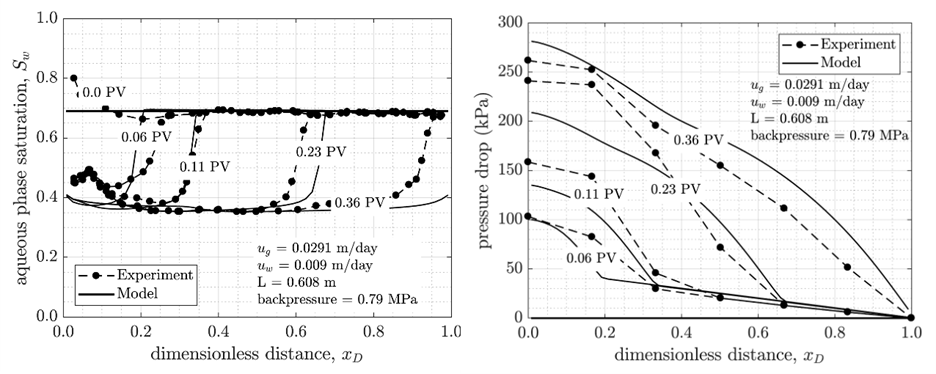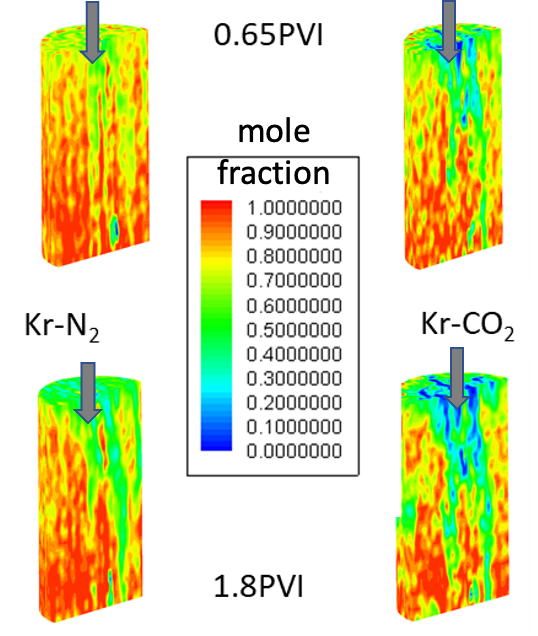Enhanced Recovery
The area of enhanced recovery combines our longtime interest in multiphase flow and rock properties with our important interest to reduce the net carbon intensity of fuels. The over-arching objective within this area is to conduct a multiscale, multiphysics, interdisciplinary laboratory study that assesses the feasibility of enhancing recovery through CO2 injection into natural gas formations and oil fields. Depleted organic-rich gas shale reservoirs may also be suitable for large-scale CO2 sequestration.
How can enhanced recovery reduce CO2 emissions?
It seems counterintuitive that injecting CO2 to produce more hydrocarbons reduces the net CO2 emissions of the hydrocarbons produced. The injection of CO2 into active producing reservoirs, however, has a profound effect on the carbon intensity of the fuels produced. For example, the density of carbon in natural gas is greater than the carbon density of CO2 at all pressures and temperatures. The important implication of this observation is that natural gas can be combusted, the resulting CO2 captured, and all of the resulting CO2 can be reinjected into the same formation. This is net zero in every sense.
Oil recovery is also a strategy to reduce net emissions. In very rough numbers, we can trace the fate of 1 (metric) tonne of CO2. If captured and injected into an oil reservoir for oil recovery, a tonne of CO2 produces, on average, about 2.5 barrels of crude oil. That crude oil when burned produces about a tonne of CO2. So, the net emissions from this oil recovery example with CCUS are roughly 1 tonne of CO2 from the crude oil because 1 tonne of CO2 remains in the earth. If there was no CCS, the burning of the crude oil produces a tonne of CO2 and we would release that original tonne of CO2 to the atmosphere for a total emission of about 2 tonnes of CO2. In other words, the combined process of capture and injection for oil recovery reduces the carbon intensity by 50%. These are rough numbers but it is evident that optimizing recovery operations such that more CO2 is injected and stored per barrel of oil produced reduces the carbon intensity further.
These examples illustrate that utilization of CO2 during hydrocarbon recovery are important steps that can be taken today to reduce emissions in the short term.
Gas in porous media
An area of significant current interest is unstable, multiphase flows in porous media as occurs during the injection of carbon dioxide that is relatively inviscid in comparison to brine and crude oil. Such dynamics are not fully described in a mechanistic or simulation framework. Given the possible need to inject large volumes of carbon dioxide into the subsurface, improved understanding of carbon dioxide for enhanced oil recovery and convincingly engineered disposal operations is needed.
An area of significant effort has been the fundamentals of the dynamics of trapping of nonwetting phase at both the pore and core scales. This work crosses over into geological carbon storage as the fundamentals are the same.
Consistent with our research in microfluidics to visualize bubble texture of aqueous foams and measure their flow resistance in idealized fractures, we have advanced substantially our ability to predict the dynamics of foam generation, coalescence, and transport in unfractured and fractured porous media using the population balance approach. Population balance frameworks are consistent with compositional reservoir simulation and provide a pathway toward understanding the mobility control achieved by foams during EOR and carbon storage operations.

Example population balance results for foam displacement in the presence of residual oil: (a) saturation profiles with initial water saturation of about 0.70 and (b) pressure drop along sandstone core. Figures courtesy of Muhammad Almajid.
Additionally, development of unconventional resources (i.e., shale) has increased U.S crude production by about 5 million barrels per day, resulting in an almost 50% decrease in the amount of imported oil. Similarly, roughly three-quarters of U.S. natural gas production is from unconventional formations. While shale production has profoundly changed energy supply; only about 5% of the original oil and about 25% of the gas in oil/gas shales is recovered. Initial productivity decreases markedly after a few months. These are excellent targets for enhanced recovery using carbon dioxide that will increase long-term productivity of these hydraulically fractured shales. SUETRI-A has contributed numerous studies detailing how gases transport through and array themselves within unconventional rocks and this work continues.

Visualization of enhanced gas recovery from an unconventional rock using nitrogen (left) and carbon dioxide (right). The arrow indicates the direction of injection. A mole fraction of 1 indicates the initial gas-saturated state. Note the permeable pathways in green in the images at 1.8 PVI. Carbon dioxide is a more effective recovery agent with about 75% of the original gas in place recovered after 5 PVI of carbon dioxide. Figures courtesy of Youssef Elkady.